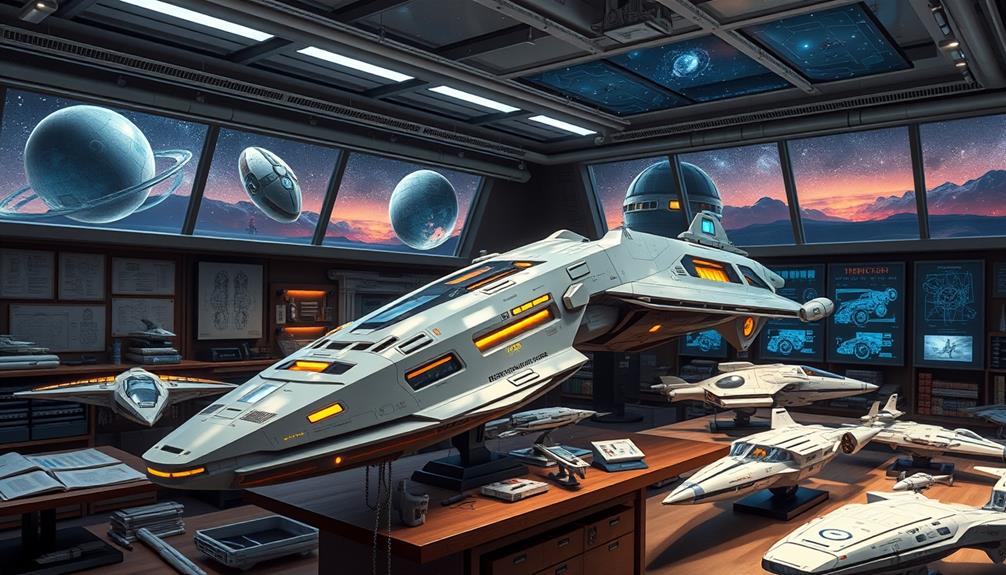Mastering the craft of spaceship design involves understanding key principles of engineering, aerodynamics, and materials science. It is important to ensure safety and functionality while also focusing on efficiency and performance. Building sturdy structures that can withstand harsh conditions and incorporating advanced propulsion systems for optimal fuel consumption are essential. Don’t forget to consider life support systems to ensure crew survival. Utilizing innovative materials such as carbon fiber and ceramics can improve durability and reduce weight. Human comfort should also be taken into account for mission success. Keep exploring to stay updated on the latest trends shaping the future of spacecraft design. Efficient and safe docking and undocking procedures are crucial in spaceship design, requiring careful planning and coordination with terminal facilities like the princess cruises southampton terminal. Embracing cutting-edge technology such as autonomous navigation systems and advanced communication networks will play a key role in enhancing the overall performance and reliability of spacecraft. Keeping up with emerging technologies and industry best practices is vital for designing the next generation of spacecraft as the industry continues to evolve.
Key Takeaways
- Prioritize aerodynamics and structural integrity to enhance stability and safety in spacecraft design.
- Utilize innovative materials like carbon fiber and ceramic composites to improve performance and durability.
- Integrate efficient propulsion systems to optimize fuel consumption and overcome gravitational challenges.
- Develop robust life support systems to ensure crew survival during long-duration missions.
- Implement effective communication strategies to maintain reliable data transmission and enhance mission efficiency.
Essentials of Spaceship Design
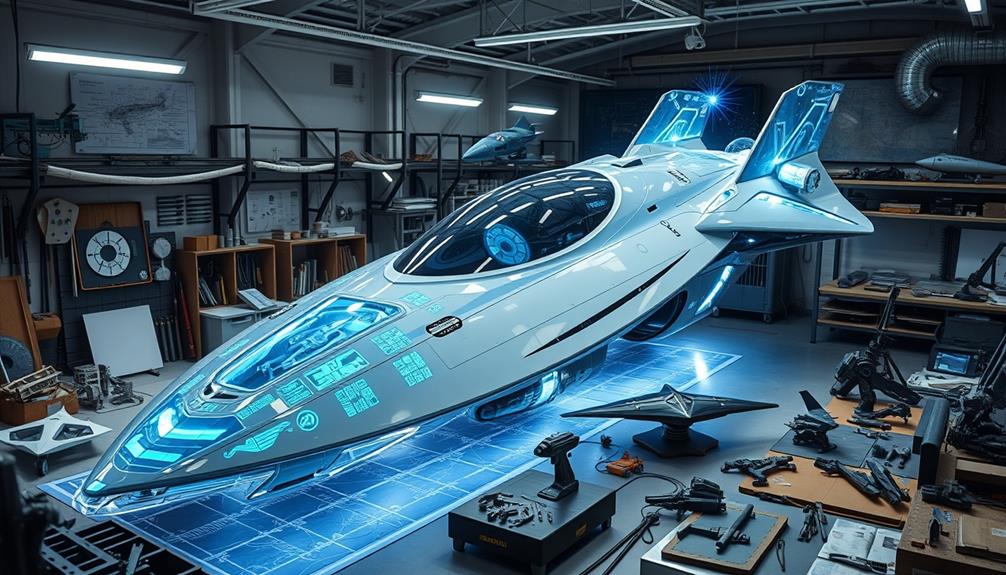
When commencing on the journey of spaceship design, understanding the essentials is essential. You need to grasp aerodynamics, as it minimizes air resistance and maximizes stability—this shaping reduces drag and enhances atmospheric movement.
Structural integrity is equally important; it guarantees safety and operational reliability throughout your design process.
Efficient propulsion systems play a key role in overcoming gravitational forces, directly impacting fuel efficiency.
Don't overlook environmental factors; robust life support systems are necessary for long-duration missions, ensuring crew survival in space.
Finally, integrating key principles like sustainability into your designs can make a significant difference.
Prioritizing these essentials lays the foundation for creating a spaceship that meets both functional and mission-specific requirements effectively.
Safety and Efficiency Standards
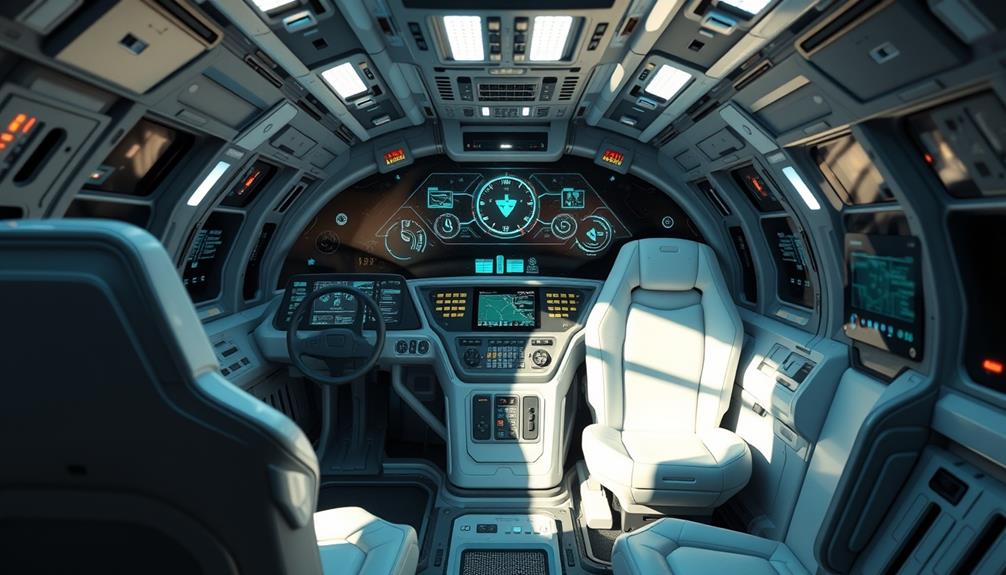
Guaranteeing the highest safety and efficiency standards is vital in spaceship design. You need to prioritize crew and passenger safety above all else, integrating robust safety measures throughout the design process. This includes creating emergency protocols that everyone can easily understand and follow.
Alongside safety, focus on efficiency—minimizing resource use and energy consumption is essential for long missions. Efficient propulsion systems play a key role in overcoming gravitational forces while conserving fuel.
You should also consider structural integrity to ascertain the spacecraft can withstand various environmental pressures. By adhering to strict regulations and certifications, you'll enhance reliability and build trust in your design.
Ultimately, striking the right balance between safety and efficiency will lead to successful spacecraft missions.
Innovative Materials in Design
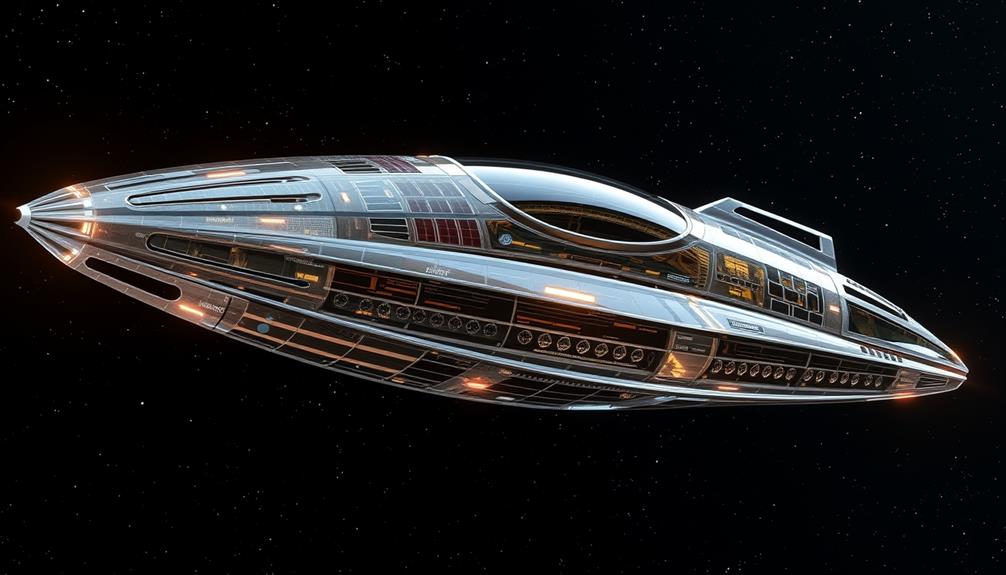
Innovative materials play a pivotal role in modern spaceship design, markedly enhancing performance and safety. By utilizing advanced composites, you can achieve a high strength-to-weight ratio, critical for reducing mass without sacrificing durability. Ceramic matrix composites resist extreme conditions, making them ideal for deep space missions.
Here's a quick overview of some innovative materials:
| Material Type | Benefits | Applications |
|---|---|---|
| Advanced Composites | High strength-to-weight ratio | Structural components |
| Ceramic Matrix Composites | Extreme temperature resistance | Heat shields |
| Carbon Fiber Reinforced Polymers | Lightweight and flexible | Fuel tanks and interiors |
Incorporating these materials not only boosts your spacecraft's performance but also guarantees safety during its journey through the cosmos.
Overcoming Design Challenges
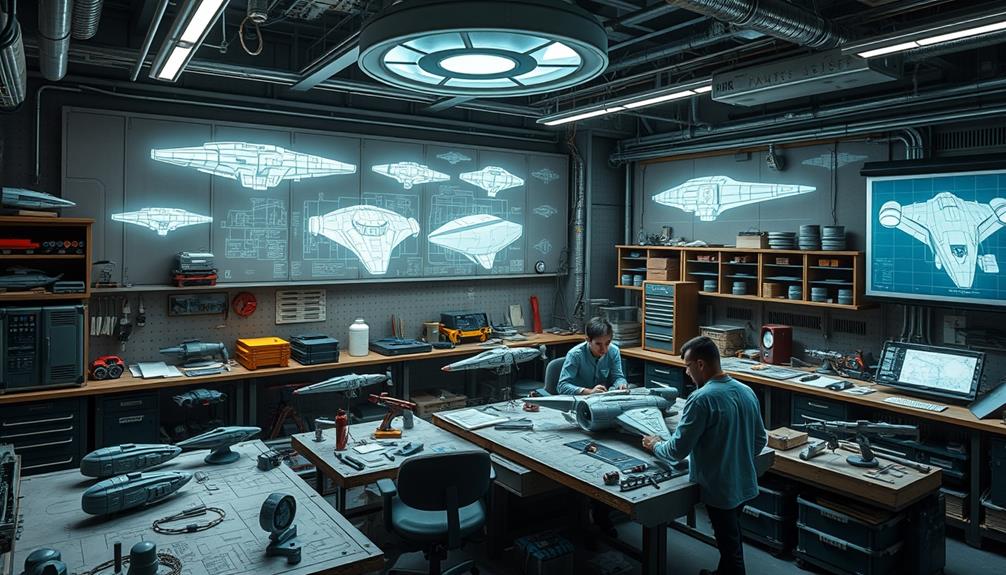
Designing a spaceship involves steering a series of complex challenges that can greatly impact its success.
You'll face issues like structural integrity, ensuring your design can withstand extreme conditions while keeping weight manageable. Prioritizing safety is essential; every decision must consider crew well-being.
Balancing efficiency with functionality can be tricky, especially when maneuvering budget constraints. You'll need to stay compliant with strict regulations, which may limit your creative options.
Don't overlook human factors—crew comfort and operational ease can considerably influence mission success.
Testing is important; thorough evaluations help you identify flaws before launch.
Effective Data Collection Methods
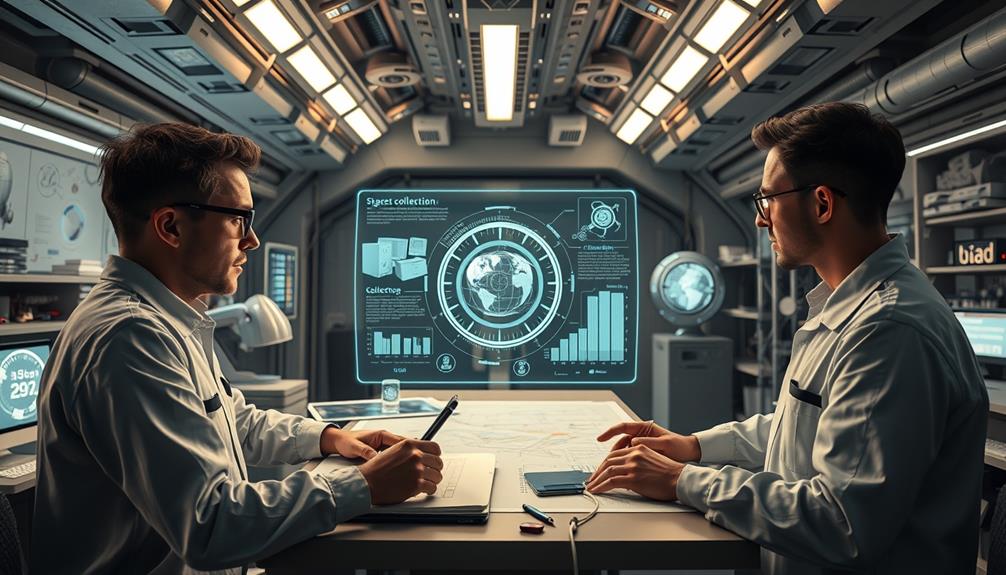
Addressing the challenges of spaceship design naturally leads to the importance of effective data collection methods. You need to optimize your experiment frequency to capture valuable insights, guaranteeing your data is both relevant and timely.
Utilize advanced technologies like AI and machine learning to analyze vast amounts of information quickly, which can enhance your decision-making process. Implement standardized protocols for data gathering to maintain consistency and reliability.
Consider incorporating sensors and monitoring tools that provide real-time feedback, helping you identify issues before they escalate. Finally, make certain your data transmission methods are robust enough to handle the vast distances involved in space, so your findings reach their intended destinations without loss.
Effective data collection is essential for refining your designs and achieving mission success.
Communication Strategies for Spacecraft
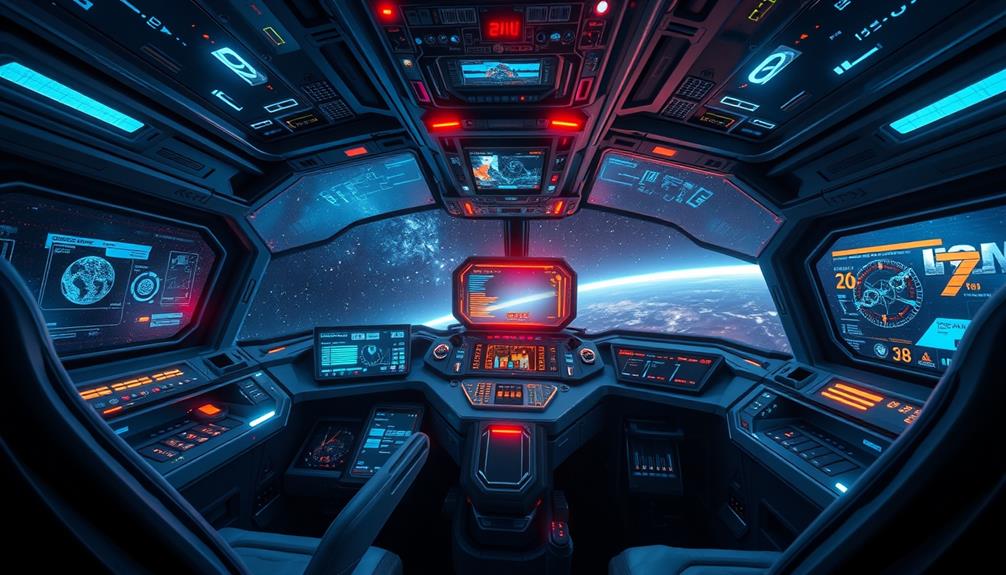
When it comes to communication strategies for spacecraft, ensuring effective data transmission across vast distances is crucial.
You'll need to design your communication systems to operate at various frequencies, allowing for reliable contact with mission control. Incorporating redundancy in your systems can prevent loss of critical data.
Consider using advanced technologies like AI to enhance cybersecurity measures, protecting your transmissions from potential threats. You'll also want to prioritize low-latency communication to allow for real-time data sharing and decision-making.
Testing your systems in simulated environments can help identify potential issues before launch.
Future Trends in Space Exploration
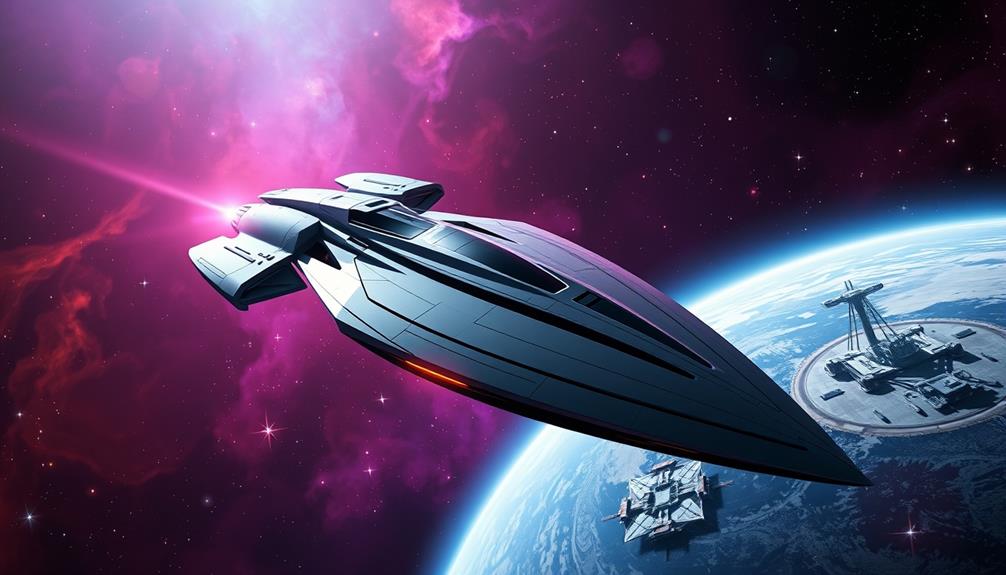
How will emerging technologies shape the future of space exploration?
You'll see advancements in propulsion systems, like ion and nuclear technology, allowing for faster travel to distant destinations.
AI and machine learning will enhance data analysis, making missions more efficient and effective.
Additionally, innovative materials such as advanced composites will reduce spacecraft weight while improving durability.
You'll also experience a shift towards sustainable practices, with a focus on recycling resources in space.
As space tourism gains traction, designs will prioritize passenger comfort and safety.
Finally, collaboration between disciplines will drive creative solutions to complex challenges, ensuring that future missions aren't only ambitious but also achievable.
Embrace these trends, and you'll be part of a new era in space exploration.
Frequently Asked Questions
What Role Does Aesthetics Play in Spaceship Design?
Aesthetics in spaceship design enhances user experience, influences emotional responses, and can improve crew morale. By creating visually appealing interiors and exteriors, you encourage engagement and foster a sense of pride in the mission.
How Do Cultural Factors Influence Spaceship Design Preferences?
Imagine a future where spaceships look like sleek smartphones. Cultural factors shape your design preferences, influencing aesthetics, functionality, and technology. Understanding regional values and historical contexts helps you create more appealing and effective spacecraft.
What Psychological Considerations Are Important for Crew Comfort?
When designing for crew comfort, you've got to take into account psychological factors like personal space, social interaction, and stress management. Ensuring a comfortable environment helps maintain morale and performance during long-duration missions.
How Can Public Opinion Impact Space Mission Designs?
Public opinion shapes space mission designs by influencing funding, priorities, and public support. When you engage with communities and consider their concerns, you guarantee missions resonate, fostering greater interest and collaboration for future exploration endeavors.
What Are the Ethical Implications of Space Exploration Design?
In the grand tapestry of space exploration, you must navigate ethical implications carefully. Consider resource allocation, environmental impact, and the potential consequences for future generations; responsibility in design shapes not just missions, but our shared destiny.
Conclusion
As you soar through the skies of spaceship design, remember that every star needs a sturdy vessel to shine. By blending safety, efficiency, and innovation, you're not just crafting a spacecraft; you're building a bridge to the cosmos. Embrace the challenges, let creativity fuel your journey, and keep your sights set on the future. Each design is a stepping stone, leading you closer to the infinite possibilities that await beyond our world. Your adventure is just beginning!
